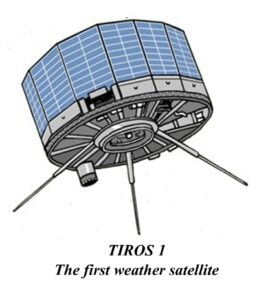
No, no, it wasn’t an April fool!
Yes, it was only just over 60 years ago, when something that we today take for granted first happened.
On that day the first ever television picture, the one above, was sent from space.
It started a revolution in television journalism.
A revolution that three years later allowed me to watch an historic event on November 25, 1963. That was the day we sat in front of our television and watched President John F. Kennedy’s funeral live in our home. I was an 18-year-old who felt he was watching history.
It didn’t take long for it to become natural and by 1968 my friends and I were coming back from the pub to watch the football matches at the Mexico World Cup, live. It had become so natural.
TIROS-1
This was the name of that first satellite, TIROS, which was actually short for Television Infrared Observation Satellite and the first pictures clearly showed the New England coast and Canada’s Maritime Provinces north to the St. Lawrence River. That I am sure you will recognise from the picture!
It was launched by NASA as the first ever weather satellite from Cape Canaveral in Florida, which is now called Cape Kennedy, it then sent its pictures back to a ground station at Fort Monmouth, New Jersey.
 It wasn’t very big, it was simply an aluminium and stainless-steel drum that was only 42 inches wide, 19 inches high and weighed 270 pounds. The clever bit was that it was covered with 9,200 solar cells, whose job was to power its two TV cameras: one high-res, one low-res. It then had five antenna, one to receive control signals from ground stations, and four to transmit TV images back to Earth. There were also on board two video recorders to store those pictures it took while on the other side of the earth.
It wasn’t very big, it was simply an aluminium and stainless-steel drum that was only 42 inches wide, 19 inches high and weighed 270 pounds. The clever bit was that it was covered with 9,200 solar cells, whose job was to power its two TV cameras: one high-res, one low-res. It then had five antenna, one to receive control signals from ground stations, and four to transmit TV images back to Earth. There were also on board two video recorders to store those pictures it took while on the other side of the earth.
In those days satellites were not always pointed towards the earth and could only operate in daylight, with the result that coverage was not continuous.
TIROS-1 only worked for 78 days, but in that time, it sent many pictures that showed clouds and how they were moving across the world.
TIRO-1’s launch gave us other benefits that being able to watch worldwide events. It’s real benefit as that it allowed us to understand our weather so much better, allowing us to be warmed on impending damaging events.
PS: Did you know?
That April 1st is an important day in the history of meteorology. It was also the day that Francis Galton (cousin of Charles Darwin) published the first newspaper weather map in The Times on 1st April 1875.
Isn’t History Fun?
10 questions to discuss:
- What was the significance of the first television picture sent from space?
- Describe the impact of the television revolution on journalism, as mentioned in the passage.
- How did the ability to watch President John F. Kennedy’s funeral live at home affect the author?
- What event in 1968 does the author mention as an example of the normalization of watching live television broadcasts?
- What does “TIROS-1” stand for, and what was its primary function?
- Where was TIROS-1 launched from, and where were its pictures transmitted back to?
- Can you describe the physical characteristics of TIROS-1?
- How long did TIROS-1 operate, and what type of images did it send back to Earth?
- What limitations did early satellites like TIROS-1 face in terms of coverage?
- Besides providing live broadcasts of global events, what other benefit did the launch of TIROS-1 offer?
For more on this incredible event click on:
Text © Tony Dalton Images ©Anthony James

